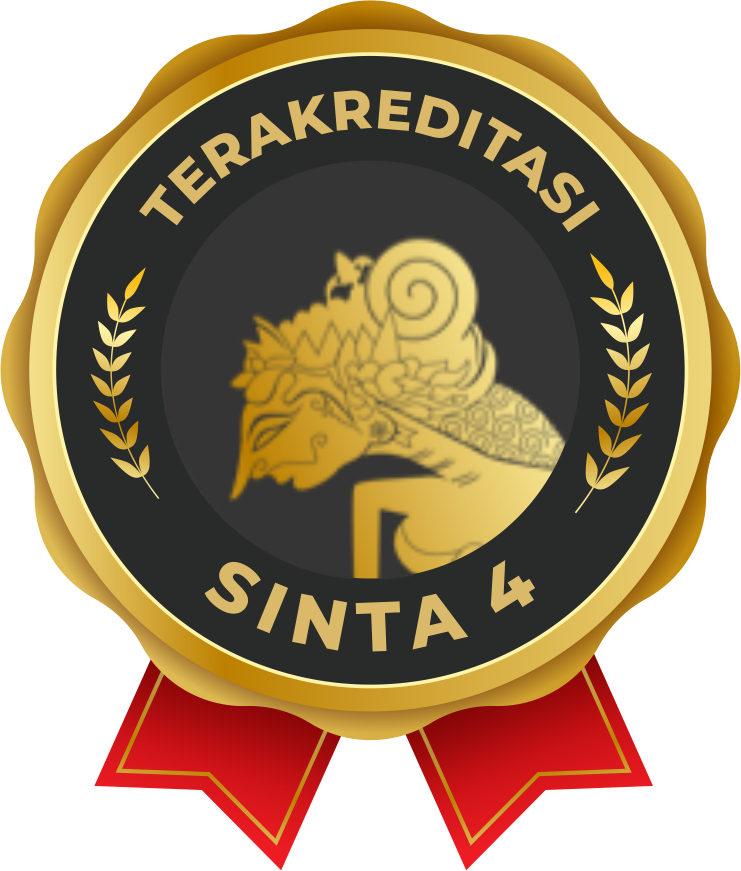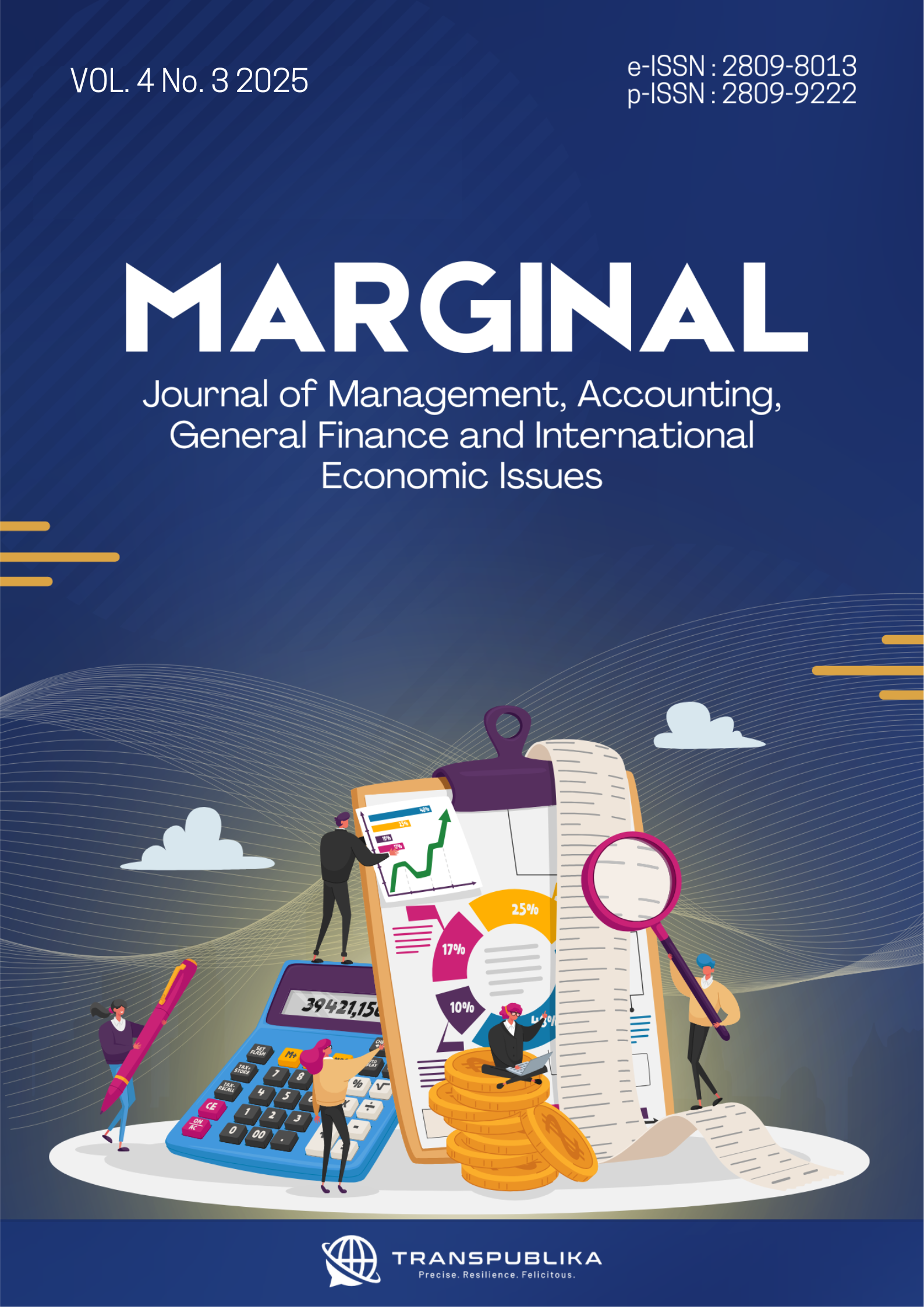The Influence of Incentives and Work Discipline on Employee Performance (Study on Pharmaceutical Companies)
Main Article Content
Umban Adi Jaya*
Indarta Priyana
Intan Rikhe
Rizki Chrisulianti
Herni Herdiani
Indonesia’s pharmaceutical industry grows 7-10% yearly with a market over IDR 100 trillion. However, companies like PT Bina San Prima struggle to improve employee performance, unsure which incentives and discipline policies work best to boost productivity and stay competitive. The main objective of this research is to investigate how incentives and adherence to rules impact the performance of employees at PT Bina San Prima, which is a pharmaceutical company located in Sukabumi. To achieve this, a quantitative method was employed, involving the use of multiple linear regression analysis to assess the connection between different factors. The study included all staff members of PT Bina San Prima, with a total of 51 participants chosen through a method of probability sampling. Information was gathered via surveys using a scale of measurement, with tests conducted to confirm the accuracy and consistency of the data-collecting tools. The examination findings reveal that both rewards (X1) and adherence to rules (X2) positively and notably impact employee productivity (Y), with adherence to rules having a more pronounced effect. An 82% coefficient of determination (R²) signals that the combined variables of rewards and adherence to rules can account for the majority of fluctuations in employee productivity, although 18% can be attributed to other factors. This research proposes enhancing discipline schemes and enhancing rewards to enhance employee productivity. Weaknesses of this research include the concentration on a restricted number of variables and the utilisation of a quantitative method that disregards the qualitative aspect.
Abrams, R. I., & Nolan, D. R. (1985). Toward a theory of just cause in employee discipline cases. Duke LJ, 594.
Adams, J. M. (2019). The value of worker well-being. Public Health Reports, 134(6), 583–586.
Al Zefeiti, S. M. B., & Mohamad, N. A. (2017). The Influence of organizational commitment on Omani public employees’ work performance. International Review of Management and Marketing, 7(2), 151–160.
Ali, Z., Bashir, M., & Mehreen, A. (2019). Managing organizational effectiveness through talent management and career development: The mediating role of employee engagement. Journal of Management Sciences, 6(1), 62–78.
Alkandi, I. G., Khan, M. A., Fallatah, M., Alabdulhadi, A., Alanizan, S., & Alharbi, J. (2023). The impact of incentive and reward systems on employee performance in the Saudi primary, secondary, and tertiary industrial sectors: A mediating influence of employee job satisfaction. Sustainability, 15(4), 3415.
Andrewartha, H. G. (2012). Introduction to the Study of Animal Populations: Reprintedition. Springer Science & Business Media.
Apalia, E. A. (2017). Effects of discipline management on employee performance in an organization: The case of county education office human resource department, Turkana County. International Academic Journal of Human Resource and Business Administration, 2(3), 1–18.
Armstrong, M. (2022). Armstrong’s Handbook of Performance Management: An Evidence-Based Guide to Performance Leadership. Kogan Page Publishers.
Astuti, D., Siregar, Z. M., & Syahputra, R. (2023). The Effect of Compensation, Transformational Leadership on Employee Commitment through Job Satisfaction as a Mediating Variable. Indonesian Interdisciplinary Journal of Sharia Economics (IIJSE), 6(1), 334–349.
Atmojo, M. (2015). The influence of transformational leadership on job satisfaction, organizational commitment, and employee performance. International Research Journal of Business Studies, 5(2).
Bauer, G. F., Hämmig, O., Cartwright, S., & Cooper, C. L. (2014). Towards organizational health: Stress, positive organizational behavior, and employee well-being. Bridging Occupational, Organizational and Public Health: A Transdisciplinary Approach, 29–42.
Campbell, D. J. (2000). The proactive employee: Managing workplace initiative. Academy of Management Perspectives, 14(3), 52–66.
Capnary, M. C., Rachmawati, R., & Agung, I. (2018). The influence of flexibility of work to loyalty and employee satisfaction mediated by work life balance to employees with millennial generation background in Indonesia startup companies. Business: Theory and Practice, 19, 217–227.
Cendriyani, Y. (2023). Achievement And Reward on Employees’ Discipline and Performance. Acman: Accounting and Management Journal, 3(2), 99–108.
Collins, D. (2010). Designing ethical organizations for spiritual growth and superior performance: An organization systems approach. Journal of Management, Spirituality & Religion, 7(2), 95–117.
Darmawan, D., Mardikaningsih, R., Sinambela, E. A., Arifin, S., Putra, A. R., Hariani, M., Irfan, M., Al Hakim, Y. R., & Issalillah, F. (2020). The quality of human resources, job performance and employee loyalty. International Journal of Psychosocial Rehabilitation, 24(3), 2580–2592.
Drake, A. R., Wong, J., & Salter, S. B. (2007). Empowerment, motivation, and performance: Examining the impact of feedback and incentives on nonmanagement employees. Behavioral Research in Accounting, 19(1), 71–89.
Dugguh, S. I., & Dennis, A. (2014). Job satisfaction theories: Traceability to employee performance in organizations. IOSR Journal of Business and Management, 16(5), 11–18.
Gomez-Mejia, L. R., & Franco-Santos, M. (2015). Creating a culture of collaboration, innovation, and performance through team based incentives. The Compensation Handbook: A State-of-the-Art Guide to Compensation Strategy and Design, 199–209.
Heinrich, C. J., & Marschke, G. (2010). Incentives and their dynamics in public sector performance management systems. Journal of Policy Analysis and Management, 29(1), 183–208.
Henley, A. (2005). From entrepreneurial aspiration to business start-up: Evidence from British longitudinal data. European Business Management School, University of Wales, Swansea.
Husada, R., & Tjandrawinata, R. R. (2013). The healthcare System and the pharmaceutical industry in Indonesia. The New Political Economy of Pharmaceuticals: Production, Innovation and TRIPS in the Global South, 134–151.
Husain, M. A. (2024). Exploring the Effectiveness Role of Board Characteristics on Firm Performance: A Study in a Sample of GCC. JOURNAL OF MANAGEMENT, ACCOUNTING, GENERAL FINANCE AND INTERNATIONAL ECONOMIC ISSUES, 3(3), 803–818. https://doi.org/10.55047/marginal.v3i3.1294
Itang. (2015). Work discipline and work competence with quality of service in the office of religious affairs (kua) district of mount kencana lebak regency of banten. J. Mgmt. & Sustainability, 5, 132.
Kabir, M. N., & Parvin, M. M. (2011). Factors affecting employee job satisfaction of pharmaceutical sector. Australian Journal of Business and Management Research, 1(9), 113–123.
Kharas, H., & Bhattacharya, A. (2023). The trillion-dollar bank: making IBRD fit for purpose in the 21st century. Brookings Center for Sustainable Development. Working Paper, 181.
Kim, H. K. (2014). Work-life balance and employees’ performance: The mediating role of affective commitment. Global Business and Management Research: An International Journal, 6(1).
Krauss, A. D., & Snyder, L. A. (2009). Technology and performance management. Performance Management, 445.
Kusuma, A., Lestari, H., & Usman, O. (2019). Influence of motivation work, discipline of work, work environment, cultural organization, and compensation to the performance of employees. Discipline of Work, Work Environment, Cultural Organization, and Compensation to the Performance of Employees (January 7, 2019).
Lima, A. R. S., Simões, P. F., & Nunes, R. M. C. (2024). Exploring Non-Financial Incentives and Motivational Strategies: A systematic review of the literature. Applied Business and Management, 432.
Lowry, G. (2016). Employee engagement: Communicating clear expectations. Seminars in Orthodontics, 22(2), 103–106.
Manjenje, M., & Muhanga, M. (2021). Financial and non-financial incentives best practices in work organisations: a critical review of literature.
Martone, D. (2003). A guide to developing a competency‐based performance‐management system. Employment Relations Today, 30(3), 23–32.
Maryani, Y., Entang, M., & Tukiran, M. (2021). The relationship between work motivation, work discipline and employee performance at the Regional Secretariat of Bogor City. International Journal of Social and Management Studies, 2(2), 1–16.
Mujtaba, B. G., & Shuaib, S. (2010). An equitable total rewards approach to pay for performance management. Journal of Management Policy and Practice, 11(4), 11–121.
Nguyen, T. H. N., & Yeh, Q.-J. (2022). Enhancing employee’s work ethics and social responsibility awareness in Chinese organisations: the roles of Confucian diligence tradition, western values and participative leadership. International Journal of Business Governance and Ethics, 16(1), 54–87.
Nugraha, B. W., & Rukhviyanti, N. (2024). The Effect of Work Engagement, Work-Life Balance, and Work Overload on Employee Productivity: The Role of Job Satisfaction as A Mediating Variable at BRI Employees in Bandung City. Indonesian Interdisciplinary Journal of Sharia Economics (IIJSE), 7(2), 3808–3833.
Odhiambo, O. J. (2018). Effect of training and development on employee performance at Safaricom Company Limited. Kca University.
Osei, A. J., & Ackah, O. (2015). Employee’s competency and organizational performance in the pharmaceutical industry. International Journal of Economics, Commerce and Management, 3(3), 1–9.
Oteshova, A. K., Niyazbayeva, A. A., Prodanova, N. A., Sabirova, R. K., & Zayed, N. M. (2021). The effect of teamwork on employee productivity. Academy of Strategic Management Journal, 20, 1–8.
Prasetiyani, D., Kustini, E., & Sari, R. (2025). The Effect Of Physical Work Environment And Work Discipline On Employee Performance At PT Sigap Dasa Perkasa In South Jakarta. International Journal Multidisciplinary Science, 4(1), 25–33.
Purwati, D., & Muhiban, A. (2023). The impact of work environment and work discipline on the performance of production section employees at pt kaneta indonesia karawang district. International Journal of Integrative Sciences, 2(12), 1911–1928.
Putra, I., & Rahayu, S. (2019). Pengelolaan talenta dan kinerja karyawan di industri manufaktur. Jurnal Sumber Daya Manusia, 9(1), 33–46.
Resnadita, N. (2020). Pengaruh Pemberdayaan Karyawan, Kerja Tim, dan Pelatihan terhadap Kepuasan Kerja. Jurnal Ilmu Manajemen, 8(3), 813. https://doi.org/10.26740/jim.v8n3.p813-817
Robbins, S. P., & Judge, T. A. (2012). Organizational behavior 15th edition. Prentice Hall.
Saint-Martin, A., Inanc, H., & Prinz, C. (2018). Job Quality, Health and Productivity: An evidence-based framework for analysis. OECD Social, Employment, and Migration Working Papers, 221, 0_1-64.
Samuel, M. O., & Chipunza, C. (2009). Employee retention and turnover: Using motivational variables as a panacea. African Journal of Business Management, 3(9), 410.
Shen, G. C., Nguyen, H. T. H., Das, A., Sachingongu, N., Chansa, C., Qamruddin, J., & Friedman, J. (2017). Incentives to change: effects of performance-based financing on health workers in Zambia. Human Resources for Health, 15, 1–15.
Simorangkir, A. C., Pakpahan, B. A. S., & Ariawan, S. (2021). The role of leadership in improving employee discipline. Jurnal Christian Humaniora, 5(1), 125–132.
Singh, J. K., & Jain, M. (2013). A study of employees’ job satisfaction and its impact on their performance. Journal of Indian Research, 1(4).
Sosiady, M. (2024). Implementation of Work Discipline and Application of Employee Sanctions In PD. BPR Rokan Hulu. InJEBA: International Journal of Economics, Business and Accounting, 2(1), 87–93.
Sucipto, A., Pratikto, H., & Winarno, A. (2025). The Moral Imperative of Human Capital: A Philosophical Analysis of HR Development for Sustainable Economic Growth in Indonesia. Enigma in Economics, 3(1), 160–172.
Sugiyono. (2013). Metode Penelitian Kuantitatif Kualitatif dan R&D. Alfabeta.
Sukawati, N. N., Gunawan, I., Ubaidillah, E., Maulina, S., & Santoso, F. B. (2020). Human resources management in basic education schools. 2nd Early Childhood and Primary Childhood Education (ECPE 2020), 292–299.
Vroom, V. H. (1964). Work and motivation. Wiley.
Wedaga, S. (2012). Assessment of the effect of disciplinary procedures on employee punctuality and performance at Anglogold Ashanti, Obuasi mine. Citeseer.
Windarko, W., Lastro, D., Iskandar, Y., & Mala, C. M. F. (2023). The Impact Of Employee Performance On Employee Productivity: Based On The Work Environment, Standard Operating Procedures (SOP), And Work Discipline. International Journal of Business, Law, and Education, 4(2), 960–970.
Yang, J.-T., & Wan, C.-S. (2004). Advancing organizational effectiveness and knowledge management implementation. Tourism Management, 25(5), 593–601.
Zhang, L., & Tang, Q. (2019). Corporate water management systems and incentives to self-discipline. Sustainability Accounting, Management and Policy Journal, 10(3), 592–616.




















